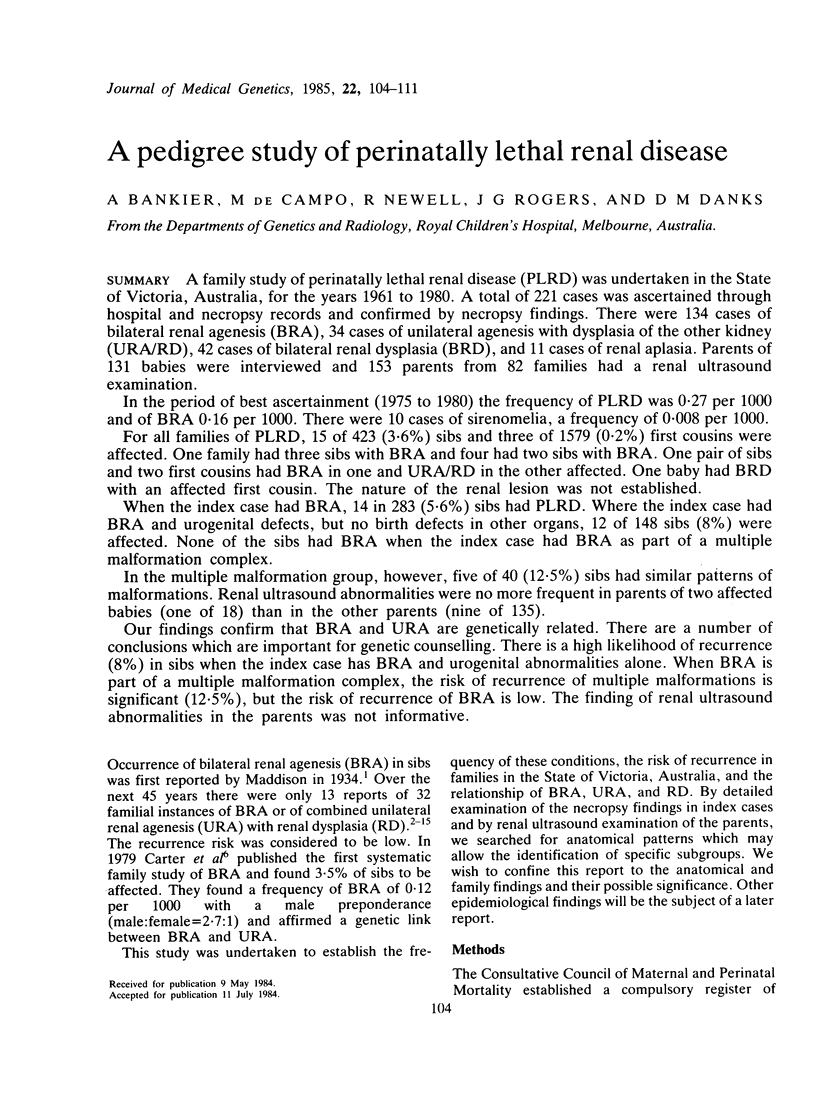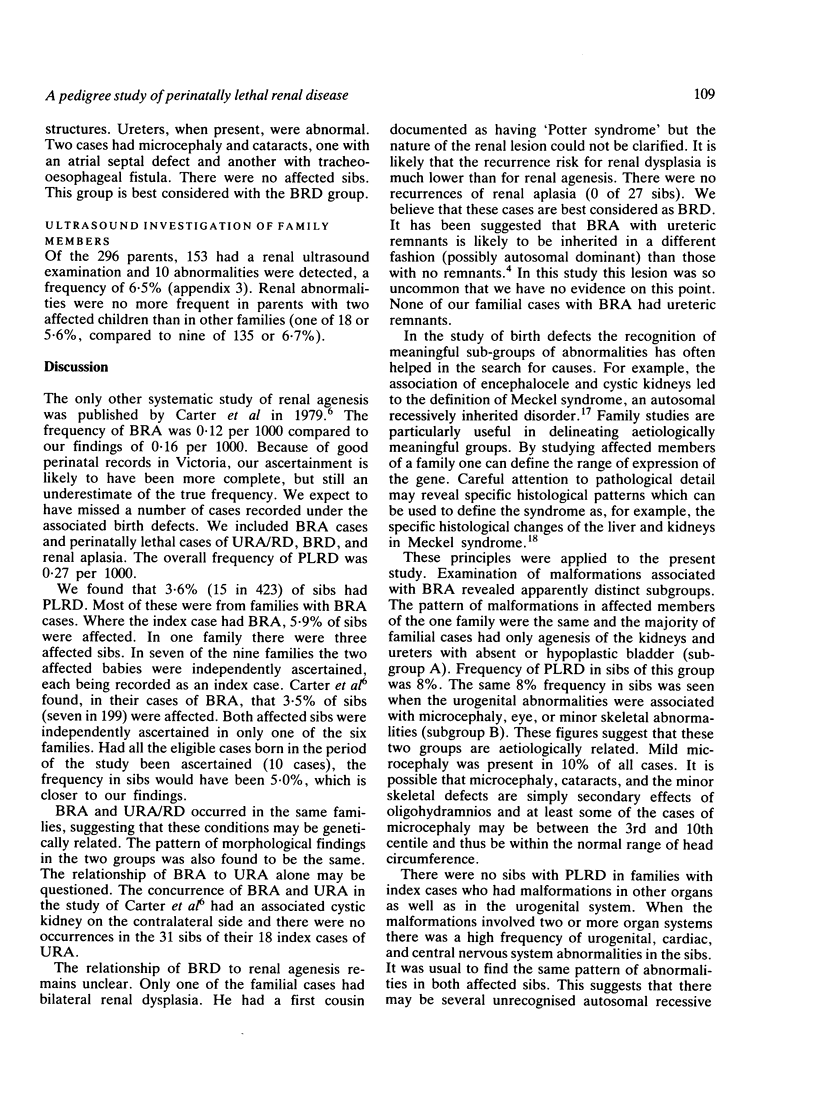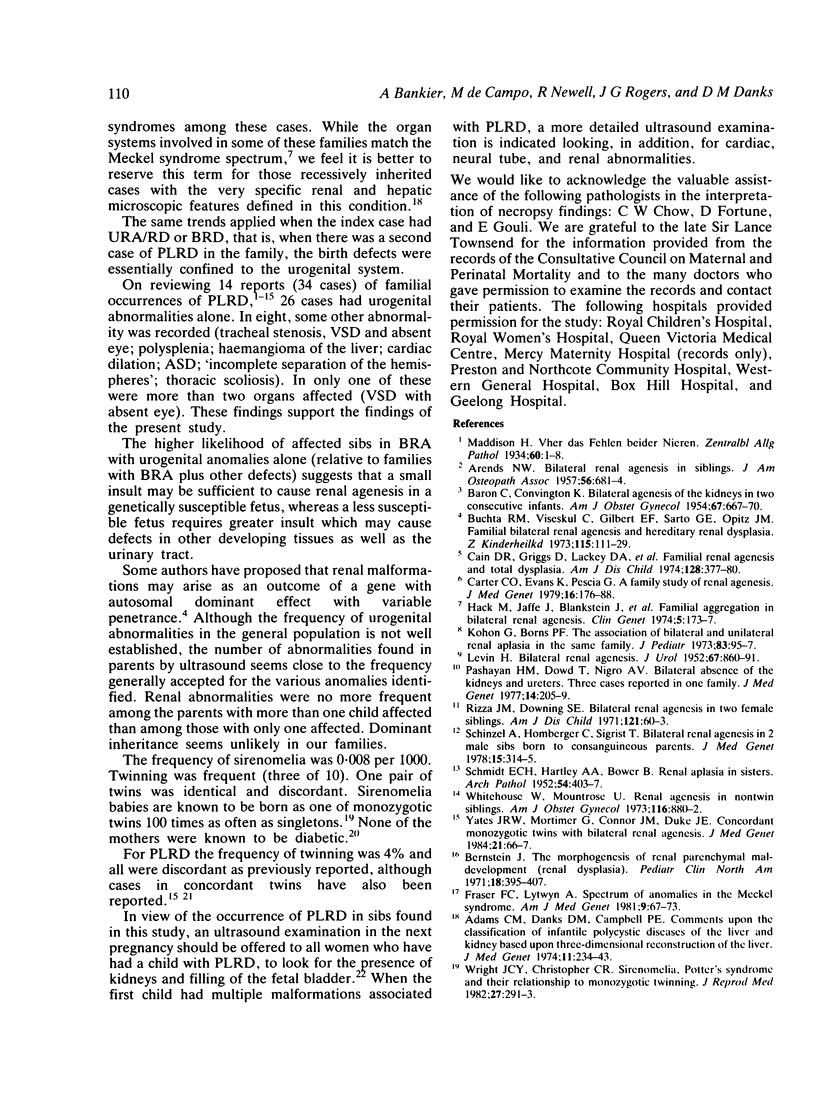Abstract
A family study of perinatally lethal renal disease (PLRD) was undertaken in the State of Victoria, Australia, for the years 1961 to 1980. A total of 221 cases was ascertained through hospital and necropsy records and confirmed by necropsy findings. There were 134 cases of bilateral renal agenesis (BRA), 34 cases of unilateral agenesis with dysplasia of the other kidney (URA/RD), 42 cases of bilateral renal dysplasia (BRD), and 11 cases of renal aplasia. Parents of 131 babies were interviewed and 153 parents from 82 families had a renal ultrasound examination. In the period of best ascertainment (1975 to 1980) the frequency of PLRD was 0.27 per 1000 and of BRA 0.16 per 1000. There were 10 cases of sirenomelia, a frequency of 0.008 per 1000. For all families of PLRD, 15 of 423 (3.6%) sibs and three of 1579 (0.2%) first cousins were affected. One family had three sibs with BRA and four had two sibs with BRA. One pair of sibs and two first cousins had BRA in one and URA/RD in the other affected. One baby had BRD with an affected first cousin. The nature of the renal lesion was not established. When the index case had BRA, 14 in 283 (5.6%) sibs had PLRD. Where the index case had BRA and urogenital defects, but no birth defects in other organs, 12 of 148 sibs (8%) were affected. None of the sibs had BRA when the index case had BRA as part of a multiple malformation complex. In the multiple malformation group, however, five of 40 (12.5%) sibs had similar patterns of malformations. Renal ultrasound abnormalities were no more frequent in parents of two affected babies (one of 18) than in the other parents (nine of 135). Our findings confirm that BRA and URA are genetically related. There are a number of conclusions which are important for genetic counselling. There is a high likelihood of recurrence (8%) in sibs when the index case has BRA and urogenital abnormalities alone. When BRA is part of a multiple malformation complex, the risk of recurrence of multiple malformations is significant (12.5%), but risk recurrence of BRA is low. The finding of renal ultrasound abnormalities in the parents was not informative.
Full text
PDF







Selected References
These references are in PubMed. This may not be the complete list of references from this article.
- ARENDS N. W. Bilateral renal agenesis in siblings. J Am Osteopath Assoc. 1957 Jul;56(11):681–684. [PubMed] [Google Scholar]
- Adams C. M., Danks D. M., Campbell P. E. Comments upon the classification of infantile polycystic diseases of the liver and kidney, based upon three-dimensional reconstruction of the liver. J Med Genet. 1974 Sep;11(3):234–243. doi: 10.1136/jmg.11.3.234. [DOI] [PMC free article] [PubMed] [Google Scholar]
- BARON C. Bilateral agenesis of the kidneys in two consecutive infants. Am J Obstet Gynecol. 1954 Mar;67(3):667–670. doi: 10.1016/0002-9378(54)90059-9. [DOI] [PubMed] [Google Scholar]
- Bernstein J. The morphogenesis of renal parenchymal maldevelopment (renal dysplasia). Pediatr Clin North Am. 1971 May;18(2):395–407. doi: 10.1016/s0031-3955(16)32558-5. [DOI] [PubMed] [Google Scholar]
- Buchta R. M., Viseskul C., Gilbert E. F., Sarto G. E., Opitz J. M. Familial bilateral renal agenesis and hereditary renal adysplasia. Z Kinderheilkd. 1973 Aug 31;115(2):111–129. doi: 10.1007/BF00440537. [DOI] [PubMed] [Google Scholar]
- Cain D. R., Griggs D., Lackey D. A., Kagan B. M. Familial renal agenesis and total dysplasia. Am J Dis Child. 1974 Sep;128(3):377–380. doi: 10.1001/archpedi.1974.02110280107016. [DOI] [PubMed] [Google Scholar]
- Carter C. O., Evans K., Pescia G. A family study of renal agenesis. J Med Genet. 1979 Jun;16(3):176–188. doi: 10.1136/jmg.16.3.176. [DOI] [PMC free article] [PubMed] [Google Scholar]
- Fraser F. C., Lytwyn A. Spectrum of anomalies in the Meckel syndrome, or: "Maybe there is a malformation syndrome with at least one constant anomaly". Am J Med Genet. 1981;9(1):67–73. doi: 10.1002/ajmg.1320090112. [DOI] [PubMed] [Google Scholar]
- Hack M., Jaffe J., Blankstein J., Goodman R. M., Brish M. Familial aggregation in bilateral renal agenesis. Clin Genet. 1974;5(2):173–177. doi: 10.1111/j.1399-0004.1974.tb01679.x. [DOI] [PubMed] [Google Scholar]
- Kohn G., Borns P. F. The association of bilateral and unilateral renal aplasia in the same family. J Pediatr. 1973 Jul;83(1):95–97. doi: 10.1016/s0022-3476(73)80324-5. [DOI] [PubMed] [Google Scholar]
- LEVIN H. Bilateral renal agenesia. J Urol. 1952 Jan;67(1):86–91. doi: 10.1016/S0022-5347(17)68318-6. [DOI] [PubMed] [Google Scholar]
- Mauer S. M., Dobrin R. S., Vernier R. L. Unilateral and bilateral renal agenesis in monoamniotic twins. J Pediatr. 1974 Feb;84(2):236–238. doi: 10.1016/s0022-3476(74)80608-6. [DOI] [PubMed] [Google Scholar]
- Pashayan H. M., Dowd T., Nigro A. V. Bilateral absence of the kidneys and ureters. Three cases reported in one family. J Med Genet. 1977 Jun;14(3):205–209. doi: 10.1136/jmg.14.3.205. [DOI] [PMC free article] [PubMed] [Google Scholar]
- Rizza J. M., Downing S. E. Bilateral renal agenesis in two female siblings. Am J Dis Child. 1971 Jan;121(1):60–63. doi: 10.1001/archpedi.1971.02100120096015. [DOI] [PubMed] [Google Scholar]
- SCHMIDT E. C. H., HARTLEY A. A., BOWER R. Renal aplasia in sisters. AMA Arch Pathol. 1952 Oct;54(4):403–406. [PubMed] [Google Scholar]
- Schinzel A., Homberger C., Sigrist T. Bilateral renal agenesis in 2 male sibs born to consanguineous parents. J Med Genet. 1978 Aug;15(4):314–316. doi: 10.1136/jmg.15.4.314. [DOI] [PMC free article] [PubMed] [Google Scholar]
- Silverman P. M., Carroll B. A., Moskowitz P. S. Adrenal sonography in renal agenesis and dysplasia. AJR Am J Roentgenol. 1980 Mar;134(3):600–602. doi: 10.2214/ajr.134.3.600. [DOI] [PubMed] [Google Scholar]
- Wright J. C., Jr, Christopher C. R. Sirenomelia, Potter's syndrome and their relationship to monozygotic twinning: a case report and discussion. J Reprod Med. 1982 May;27(5):291–294. [PubMed] [Google Scholar]


